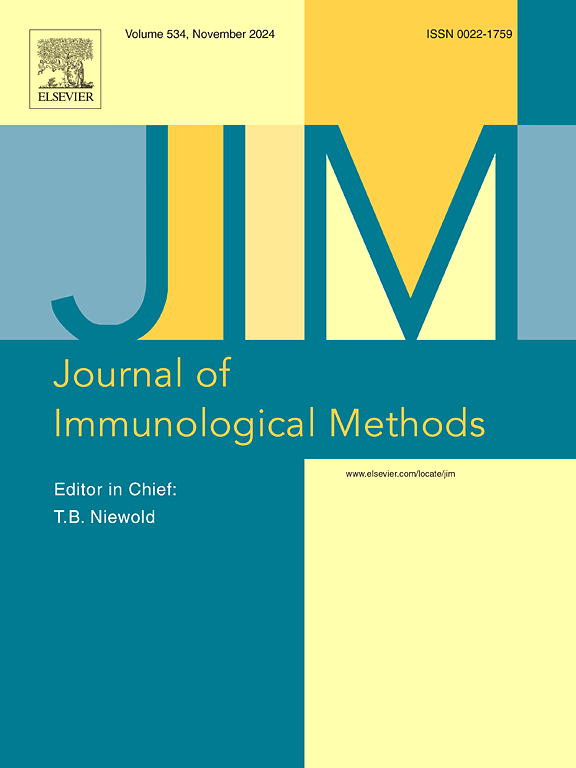Development and laboratory validation of an electrochemiluminescence ELISA technique for measuring infliximab concentrations and anti-drug antibodies
IF 1.6
4区 医学
Q4 BIOCHEMICAL RESEARCH METHODS
引用次数: 0
Abstract
Infliximab is a monoclonal biologic medication used to treat inflammatory and autoimmune disorders. Effective patient management involves quantifying the drug's therapeutic levels and timely detection of anti-drug antibodies (ADA). In this study, we show results of the development and clinical laboratory validation of an electrochemiluminescence immunoassay (ECLIA). The ADA assay employs a bridging ELISA format with biotinylated infliximab as the capture molecule and ruthenium-labeled infliximab as the reporter. For the drug assay, a sandwich format was developed using a biotinylated tumor necrosis factor as the capture molecule and an anti-idiotypic antibody fragment specific to infliximab as the reporter. During assay development, the optimal concentrations for the capture and reporter reagents in both ADA and drug assays were determined. The validation assessed accuracy through two methods: a reporter gene assay (RGA) and sending residual clinical samples to a peer lab utilizing ECLIA methodology. The ADA assay showed a combined 96.1 % qualitative agreement with both RGA and peer ECLIA methods. For the drug assay, comparison with the peer ECLIA method revealed a positive correlation (R2 = 0.79) with a Deming Regression slope of 1.02 (95 % CI, 0.86–1.18). Despite also having a positive correlation (R2 = 0.82) with the RGA, the drug assay slope was only 0.71 (95 % CI, 0.60–0.83), indicating functional differences between methodologies. Both assays displayed inter- and intra-assay precision below 25 % coefficient of variance. Linearity studies and analytical sensitivity tests indicated the analytical measurement range was 20–1500 ng/mL for the ADA assay and 0.5–40 μg/mL for the drug assay. In conclusion, validation of the infliximab ADA and drug assays demonstrated high sensitivity, precision, and accuracy, meeting criteria for the detection and quantification of infliximab and related antibodies in clinical patient testing.
用于测量英夫利昔单抗浓度和抗药物抗体的电化学发光ELISA技术的开发和实验室验证
英夫利昔单抗是一种单克隆生物药物,用于治疗炎症和自身免疫性疾病。有效的患者管理包括量化药物的治疗水平和及时检测抗药物抗体(ADA)。在这项研究中,我们展示了电化学发光免疫测定(ECLIA)的发展和临床实验室验证的结果。ADA检测采用桥接ELISA格式,生物素化英夫利昔单抗作为捕获分子,钌标记英夫利昔单抗作为报告分子。对于药物分析,采用生物素化肿瘤坏死因子作为捕获分子和英夫利昔单抗特异性抗独特型抗体片段作为报告细胞的三明治格式。在试验开发过程中,确定了ADA和药物试验中捕获和报告试剂的最佳浓度。验证通过两种方法评估准确性:报告基因测定(RGA)和使用ECLIA方法将剩余临床样本发送到同行实验室。ADA测定结果与RGA和ECLIA方法的定性一致性为96.1%。对于药物分析,与同行ECLIA方法比较显示正相关(R2 = 0.79), Deming回归斜率为1.02 (95% CI, 0.86-1.18)。尽管与RGA也有正相关(R2 = 0.82),但药物分析斜率仅为0.71 (95% CI, 0.60-0.83),表明方法之间的功能差异。两种测定法的测定间和测定内精度均低于25%的方差系数。线性研究和分析灵敏度试验表明,ADA法的分析测量范围为20 ~ 1500 ng/mL,药物法的分析测量范围为0.5 ~ 40 μg/mL。综上所述,验证英夫利昔单抗ADA和药物分析具有较高的敏感性、精密度和准确性,满足临床患者试验中英夫利昔单抗及相关抗体的检测和定量标准。
本文章由计算机程序翻译,如有差异,请以英文原文为准。
求助全文
约1分钟内获得全文
求助全文
来源期刊
CiteScore
4.10
自引率
0.00%
发文量
120
审稿时长
3 months
期刊介绍:
The Journal of Immunological Methods is devoted to covering techniques for: (1) Quantitating and detecting antibodies and/or antigens. (2) Purifying immunoglobulins, lymphokines and other molecules of the immune system. (3) Isolating antigens and other substances important in immunological processes. (4) Labelling antigens and antibodies. (5) Localizing antigens and/or antibodies in tissues and cells. (6) Detecting, and fractionating immunocompetent cells. (7) Assaying for cellular immunity. (8) Documenting cell-cell interactions. (9) Initiating immunity and unresponsiveness. (10) Transplanting tissues. (11) Studying items closely related to immunity such as complement, reticuloendothelial system and others. (12) Molecular techniques for studying immune cells and their receptors. (13) Imaging of the immune system. (14) Methods for production or their fragments in eukaryotic and prokaryotic cells.
In addition the journal will publish articles on novel methods for analysing the organization, structure and expression of genes for immunologically important molecules such as immunoglobulins, T cell receptors and accessory molecules involved in antigen recognition, processing and presentation. Submitted full length manuscripts should describe new methods of broad applicability to immunology and not simply the application of an established method to a particular substance - although papers describing such applications may be considered for publication as a short Technical Note. Review articles will also be published by the Journal of Immunological Methods. In general these manuscripts are by solicitation however anyone interested in submitting a review can contact the Reviews Editor and provide an outline of the proposed review.

 求助内容:
求助内容: 应助结果提醒方式:
应助结果提醒方式:


